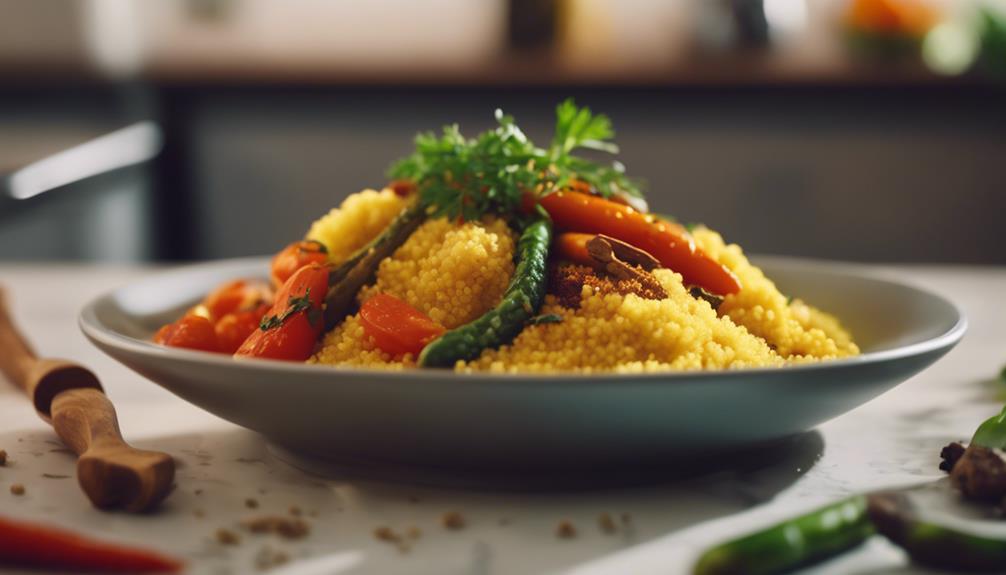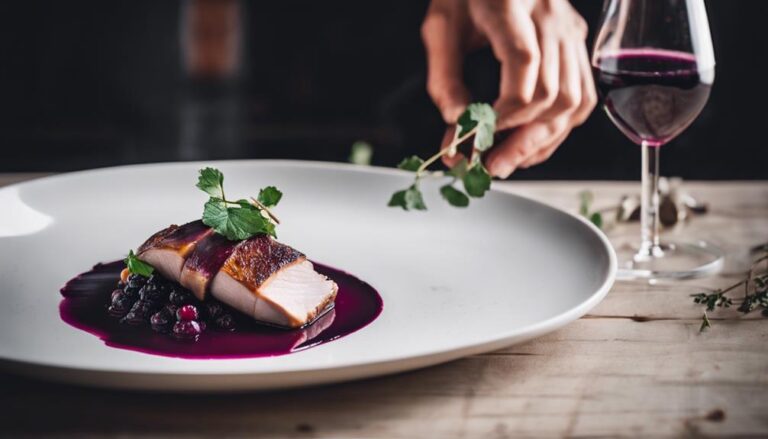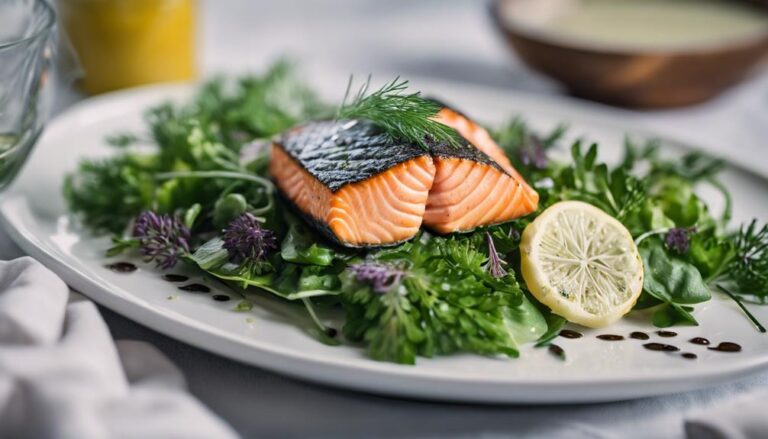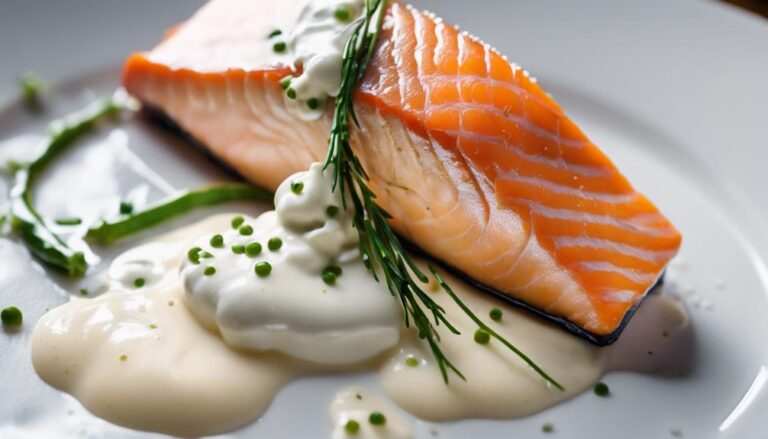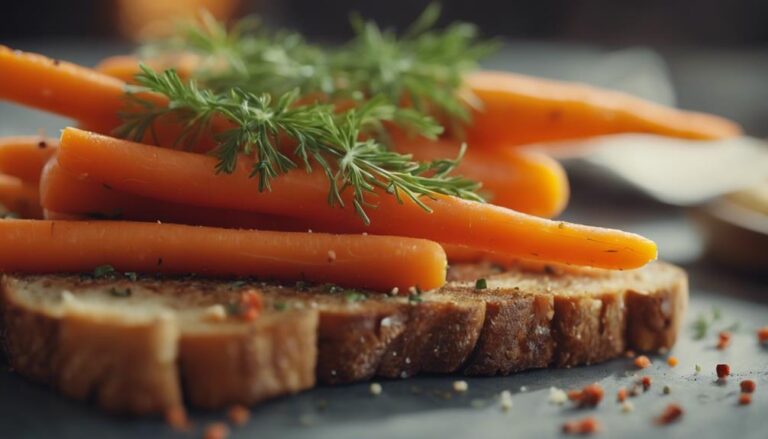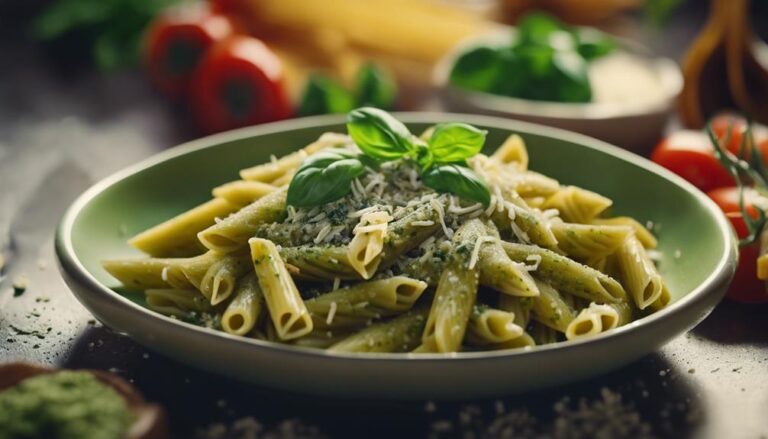Sous Vide Moroccan Spiced Vegetables Over Couscous
Immerse your taste buds in the exotic fusion of flavors when you try sous vide Moroccan spiced vegetables atop a bed of fluffy couscous. Picture tender vegetables infused with the warm essence of cumin, cinnamon, turmeric, and paprika, creating a harmony of sweet and savory notes that dance on your palate. Each bite offers a vibrant celebration of Moroccan gastronomy, a modern twist on time-honored techniques. Let yourself savor the essence of Morocco with this colorful and aromatic dish that promises to transport you to bustling Moroccan markets.
What You Will Learn Here
- Enhance vegetables with Moroccan spice blend through sous vide cooking.
- Vacuum-seal vegetables with spices for intensified flavors.
- Season vegetables with salt before sealing for enhanced taste.
- Slow cooking process ensures deep, complex flavors in vegetables.
- Maintain vegetable texture for a satisfying couscous dish experience.
Culinary Roots of Moroccan Cuisine

Step into the rich tapestry of Moroccan culinary heritage, where the flavors of Berber, Arab, and Mediterranean traditions intertwine to create a vibrant gastronomic experience.
Explore the warm embrace of cumin, cinnamon, turmeric, and paprika that infuse Moroccan dishes with their distinctive and aromatic profiles.
Uncover the time-honored techniques that shape Moroccan cuisine, where the delicate balance of sweet and savory dances on the taste buds, promising a culinary journey like no other.
Culinary Heritage Overview
In the culinary tapestry of Morocco, a rich fusion of Berber, Arab, and Mediterranean influences weaves together to create the vibrant and diverse flavors that define Moroccan cuisine. Moroccan culinary heritage is deeply rooted in the use of aromatic spices like cumin, cinnamon, and paprika, which add depth and complexity to dishes.
Lamb is a staple meat in Moroccan cooking, often slow-cooked to tender perfection in tagines with a blend of spices, creating a harmonious marriage of flavors. The traditional cooking methods in Morocco involve slow simmering or braising, allowing the flavors to meld together over time, resulting in dishes that are rich, savory, and aromatic.
This heritage celebrates the art of blending spices and ingredients to create a culinary experience that's both comforting and exciting.
Moroccan Flavor Profiles
In the vibrant tapestry of Moroccan culinary tradition, the fusion of Berber, Arab, and Mediterranean influences intricately intertwines to create the signature flavor profiles that define Moroccan cuisine. The essence of Moroccan flavors lies in the artful combination of sweet and savory notes, where cumin, cinnamon, turmeric, and paprika dance harmoniously to tantalize the taste buds.
Ingredients like preserved lemons, olives, dates, and nuts add depth and richness to dishes, creating a sensory experience that transports you to the bustling markets of Morocco. These flavor profiles, deeply rooted in tradition, are elevated through modern techniques like sous vide cooking, allowing the intricate blend of spices and ingredients to infuse and intensify, promising a culinary journey that celebrates the heart of Moroccan gastronomy.
Traditional Cooking Techniques
Embrace the rich tapestry of Moroccan culinary heritage, where a fusion of Arab, Berber, and Mediterranean influences intertwines to shape the traditional cooking techniques that form the very roots of this vibrant cuisine.
In Moroccan cooking, the method of sous vide, slow simmering, grilling, and roasting are commonly employed to develop rich and deep flavors in dishes like succulent lamb chops. This culinary tradition also celebrates the art of using a blend of spices such as cumin, coriander, cinnamon, turmeric, and paprika to create intricate flavor profiles.
Additionally, the inclusion of preserved lemons, olives, and dried fruits adds a delightful sweet and savory contrast to many authentic Moroccan recipes. Couscous, a beloved staple, is meticulously steamed to perfection and serves as a versatile base for various tagines and vegetable dishes.
Signature Moroccan Spice Blend
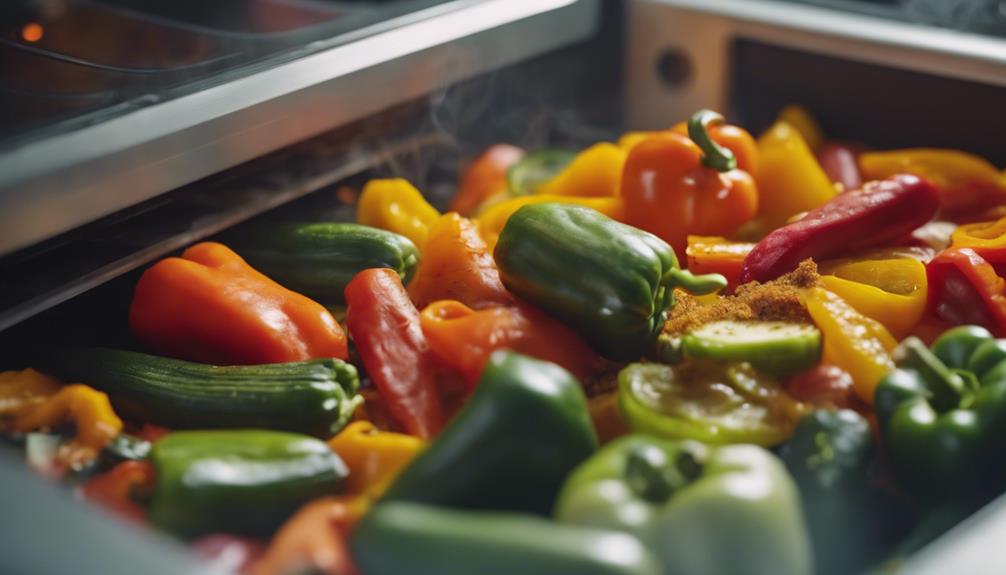
For a culinary adventure that tantalizes the taste buds and transports you to the vibrant streets of Morocco, consider delving into the world of the signature Moroccan spice blend. This exotic mix is a cornerstone of Moroccan cuisine, infusing dishes with a symphony of flavors that dance on the palate. Here's what makes this spice blend truly special:
- Cumin: Known for its warm and earthy notes, cumin forms the base of the blend, providing a rich and smoky undertone to dishes.
- Coriander: Adding a citrusy and slightly floral essence, coriander brightens up the blend, balancing the other spices harmoniously.
- Paprika, Cinnamon, and Ginger: These three ingredients come together to deliver a medley of sweet, spicy, and aromatic elements, elevating the flavor profile to new heights.
Whether you're seasoning meats, vegetables, or grains like couscous, incorporating this signature Moroccan spice blend will without a doubt transport your taste buds to the bustling markets of Marrakech, creating an unforgettable dining experience for you and your guests.
Tasty Moroccan-inspired Dishes
Indulge in the enticing flavors of savory Moroccan Lamb Tagine, a hearty dish that combines tender lamb with a medley of spices and dried fruits for a truly rich experience.
For a lighter option, try the Spiced Moroccan Vegetable Medley, a colorful and aromatic blend of veggies seasoned with traditional North African spices.
If you're in the mood for something unique, explore the Moroccan Carrot Sous Vide, a modern twist on a classic dish that will delight your taste buds with its sweet and spicy profile.
Savory Moroccan Lamb Tagine
Delight your taste buds with the savory essence of a traditional Moroccan Lamb Tagine, a slow-cooked masterpiece bursting with aromatic spices and tender meat. This North African delicacy is a flavorful journey, combining the richness of slow-cooked lamb with a symphony of spices and textures.
Here's what makes this dish truly special:
- The tender lamb, infused with cumin and cinnamon, melts in your mouth.
- The medley of vegetables and dried fruits adds a delightful sweetness to every bite.
- The blend of Moroccan spices like ras el hanout creates a harmonious flavor profile that tantalizes your palate.
Indulge in this exquisite dish, where each spoonful transports you to the vibrant streets of Morocco.
Spiced Moroccan Vegetable Medley
Experience the vibrant flavors of Morocco with a tantalizing Spiced Moroccan Vegetable Medley. This dish features a colorful array of red onion, parsnips, turnips, and carrots harmoniously blended with chickpeas and a fragrant mix of curry powder, turmeric, cumin, and cinnamon. Imagine the aroma of these spices infusing the vegetables, creating a mouthwatering dish that delights the senses.
The sous vide cooking method guarantees that all the flavors meld together perfectly, resulting in tender vegetables bursting with Moroccan essence. This Spiced Moroccan Vegetable Medley isn't only a feast for the taste buds but also a visually appealing dish that will elevate any dining experience.
- Tender vegetables infused with exotic Moroccan spices
- Sous vide cooking method for flawless flavor integration
- Colorful and aromatic dish that transports you to the streets of Marrakech
Moroccan Carrot Sous Vide
Transport yourself to the vibrant streets of Marrakech with the tantalizing flavors of sous vide Moroccan Carrot, infused with a rich blend of ras el hanout spice mix. These heirloom carrots, seasoned to perfection, are a delightful addition to any meal. Here's what makes this dish stand out:
- Heirloom carrots are cooked to perfection using the sous vide method, ensuring a tender and flavorful outcome.
- The addition of sweet, plumped golden raisins adds a burst of sweetness that complements the savory spices beautifully.
- Butter-toasted pine nuts provide a crunchy texture that enhances the overall culinary experience.
To recreate this dish at home, simply toss the carrots with a teaspoon of olive oil and ras el hanout spice mix before sous vide cooking for a truly unforgettable taste sensation.
Enhancing Moroccan Dish Flavors
To elevate the flavors of your Moroccan dish, experiment with bold spice combinations like the warm blend of curry powder, turmeric, cumin, and cinnamon.
Incorporate traditional Moroccan ingredients such as root vegetables like parsnips, turnips, and carrots for a hearty and earthy flavor profile.
Implement culinary techniques like serving the dish over cooked couscous to enhance the experience with a light and fluffy texture.
Flavorful Spice Combinations
Enhance the vibrant flavors of your Moroccan spiced vegetables by skillfully blending a medley of aromatic spices like Ras el Hanout, turmeric, cumin, and cinnamon for a culinary journey through North African cuisine.
The Ras el Hanout spice blend, with its mix of cumin, ginger, cinnamon, coriander, and more, creates a complex flavor profile that elevates the dish.
Turmeric, cumin, and cinnamon bring warmth, earthiness, and depth to the vegetables, enriching their taste. Consider adding a touch of harissa for a spicy kick and smoky undertones, perfectly complementing the Moroccan spice blend.
The sweet, savory, and spicy notes in these spice combinations work harmoniously to enhance the overall taste and aroma of your Moroccan spiced vegetables, creating a truly memorable dining experience.
Traditional Moroccan Ingredients
Incorporate the vibrant flavors of traditional Moroccan ingredients like ras el hanout spice blend, preserved lemons, and harissa sauce to elevate the authenticity and richness of your Moroccan dishes.
When preparing Moroccan spiced lamb, consider using a small bowl to mix the ras el hanout spice blend with olive oil, creating a marinade that will infuse the meat with a myriad of warm and aromatic flavors.
Adding preserved lemons to tagines or couscous dishes lends a unique tangy and slightly sweet note, balancing the richness of the other ingredients.
Harissa sauce, with its fiery kick from chili peppers, can be drizzled over roasted vegetables or used as a marinade for grilled meats, intensifying the overall flavor profile of your Moroccan culinary creations.
Culinary Techniques for Depth
For a culinary experience that delves deeply into the flavors of Moroccan cuisine, consider employing the precise art of sous vide cooking to elevate your vegetable dishes to new heights of taste and texture.
Sous vide cooking guarantees that the Moroccan spiced vegetables are perfectly cooked, retaining their flavors and textures. By vacuum-sealing the vegetables with the rich Moroccan spices such as curry powder, turmeric, cumin, and cinnamon, you can enhance the depth of flavor in the dish.
Seasoning with salt before sealing the vegetables allows the flavors to penetrate fully, resulting in a more intense and well-rounded taste. This technique prevents the vegetables from becoming mushy, preserving their natural textures for a satisfying eating experience.
The slow cooking process in sous vide allows for a perfectly infused dish with deep, complex flavors that complement the couscous beautifully.
Final Thoughts
Reflecting on the harmonious blend of warm Moroccan spices and hearty root vegetables in this sous vide dish leaves you with a lingering sense of culinary satisfaction. The way the red onion caramelizes alongside the parsnips, turnips, and carrots, infusing the dish with sweetness, is truly a delight to experience. The use of a sheet pan to roast these vegetables before incorporating them into the sous vide process adds a depth of flavor that's unmatched. The pairing of the earthy garbanzo beans with the fragrant blend of curry powder, turmeric, cumin, and cinnamon creates a symphony of taste that dances on your palate.
As you serve this vegan and dairy-free creation over a bed of fluffy couscous, garnished with fresh parsley and a dollop of spicy harissa, you can't help but feel a sense of pride in presenting such a vibrant and flavorful dish. The versatility of being able to store leftovers in the fridge for up to three days allows you to savor this culinary masterpiece time and time again.
Frequently Asked Questions
What Are the Best Vegetables to Sous Vide?
When it comes to sous vide, broccoli and carrots shine for their hearty textures and flavors. Asparagus and bell peppers are other top picks, offering a delightful balance of taste and tenderness. Customize with seasonings for a mouthwatering experience.
Is It Worth It to Sous Vide Vegetables?
Pros of sous vide cooking vegetables include enhanced flavors, nutrients, and textures. Cons may involve longer cooking times. This method guarantees precise temperature control for perfect results every time. It's worth it for delicious and consistent vegetable dishes.
Why Is Couscous the National Dish of Morocco?
Couscous holds the title of Morocco's national dish due to its rich history and profound cultural significance. A symbol of togetherness and hospitality, this versatile grain reflects Morocco's culinary heritage with pride and tradition.
What Is Couscous Made of in Morocco?
In Morocco, couscous is made from durum wheat semolina, coarsely ground into tiny granules. The traditional preparation involves steaming it in a couscoussier to achieve a light, fluffy texture. This staple grain holds cultural significance, symbolizing hospitality and togetherness.
Conclusion
Indulge in the exotic flavors of Morocco with this sous vide Moroccan spiced vegetables over couscous dish.
The tender vegetables, infused with aromatic spices, pair perfectly with fluffy couscous for a satisfying meal that will transport your taste buds to the bustling markets of Marrakech.
Experience the rich culinary heritage of Morocco in every bite, and elevate your cooking skills with this flavorful and vibrant dish.
Bon appétit!
